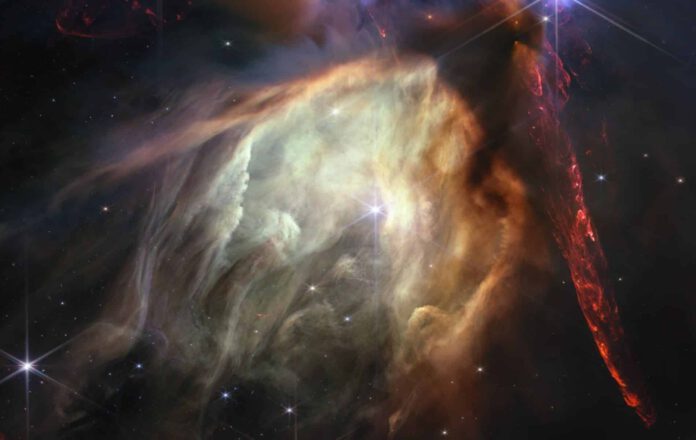
You – loyal readers of Scientias.nl – have spoken: the most beautiful space photo of this year is – again! – taken by James Webb.
From Christmas Day onwards, as per tradition, votes could be cast on Scientias.nl for the most beautiful space photo of the year. And we certainly noticed! Hundreds of people have voted in the past few days, leading to a clear winner: the photo below!
First Place
The winning photo – like last year, by the way – was taken by the James Webb space telescope. The American and European space agencies released the photo in July this year, marking the ‘first anniversary’ of Webb’s operation. The photo brilliantly depicts a star-forming area in the multiple star system Rho Ophiuchi. The area hosts no less than 50 newborn stars. Some of these stars are surrounded by shadows that hint at the presence of protoplanetary disks from which planets could be born in time.
Second Place
James Webb’s immortalisation of young stars were apparently well-liked. In second place, we find yet another photo by James Webb, featuring – yes – another brilliantly shining star in the making. It is a truly spectacular photo of Herbig-Haro object 211. Herbig-Haro objects are small emission nebulae around young stars created as the newly formed stars emit gas. This gas collides at high speed with other gas and dust clouds in the area, creating the nebulae you see shining in this photo.
Third Place
And in third place, we find another photo of James Webb, with young stars as the main focus yet again. This photo shows a pair of actively forming stars, known as Herbig-Haro 46/47. The newborn stars are situated right in the centre, within the orange-white spot, deeply buried in a gas and dust disc that they feed on (and which facilitates their ongoing mass increase). Of obvious note, are the two jet streams that emanate from the actively growing stars (in fiery orange), consisting of material that the stars have expelled.
Fourth Place
In fourth place, we find another breathtaking photograph, surprisingly not captured by James Webb. The shot – taken by the recently repaired Gemini North telescope – features the Windmill Galaxy, alias Messier 101. The galaxy houses nearly a trillion stars and the closest supernova observed in the past five years. The aftermath of this event is clearly visible in the photo: the bright spot in the spiral arm on the left in the image.
Fifth Place
In fifth place, we return to a photo by James Webb. This time, it’s the Crab Nebula: one of the most renowned supernova remnants. At the heart of the nebula, a neutron star – or pulsar – rotates on its axis 30 times every second. The nebula has been captured thousands of times, but James Webb’s extremely detailed recording manages to surprise both scientists and enthusiasts.
Sixth Place
In sixth place, predictably yet impressively, is another photo by James Webb. This photo features something we had never seen before unlike the aforementioned Crab Nebula: two star-formation regions in the frequently studied Small Magellanic Cloud. In the dusty ‘ribbons’ of this image, astronomers found hints that many new stars are being born there.
Seventh Place
In seventh place, a newcomer takes the spotlight: Euclid. The telescope was launched last summer and delivered its first colour photos this autumn. Astronomers were thrilled: the images were crystal clear. “We have not seen astronomical images with so much detail before,” said René Laureijs, who works within the Euclid team. “They are even more beautiful and sharper than we had dared to hope and show us many as-yet-unobserved features in familiar parts of the nearby universe.” A total of five colour photos from Euclid were released this autumn, including one featuring the famous and extremely photogenic Horsehead Nebula. This photo grabbed seventh place in our top 10 most beautiful space photos!
Eighth Place
The eighth place is claimed again by James Webb with a photo of Uranus. The planet has been immortalised several times before, yet the images from James Webb are stunning. Apart from Uranus itself, James Webb also captures the complex ring system, a bright polar cap, and likely even storm clouds on the planet! With this, the telescope reveals that this planet – often appearing as a seemingly dull, smooth, blue-green ball in previous images – is more exciting and dynamic than we thought.
Ninth Place
In ninth place, we find the only space photo in this election taken by an astrophotographer. In this picture, taken by Kenneth Lerose, the comet Nishimura shines brightly. This comet swooped by the sun in September. Quite remarkable, because the last time it visited the inner part of the solar system, our ancestors were engaged in the Eighty Years’ War! The photo that Lerose took of the comet showcases not only the comet but also its long, bright tail. A stunning image!
Tenth Place
And finally, the grand finale: in tenth place, we find a photo taken by the South Korean moon orbiter Danuri. You might find the image familiar, and rightly so. It’s a kind of remake of the well-known Earthrise photo taken during the Apollo 8 mission in 1968. This photograph also captures the Earth rising behind the moon’s surface. This one, however, is much sharper than the 1968 version. Add a touch of nostalgia to the mix, and it’s no surprise that it squeezes into the top 10 of our space photo contest at the last minute!
And with that, our top 10 is complete. Thank you for voting! On behalf of the entire editorial staff, we wish you all a very happy new year and all the best for 2024!











